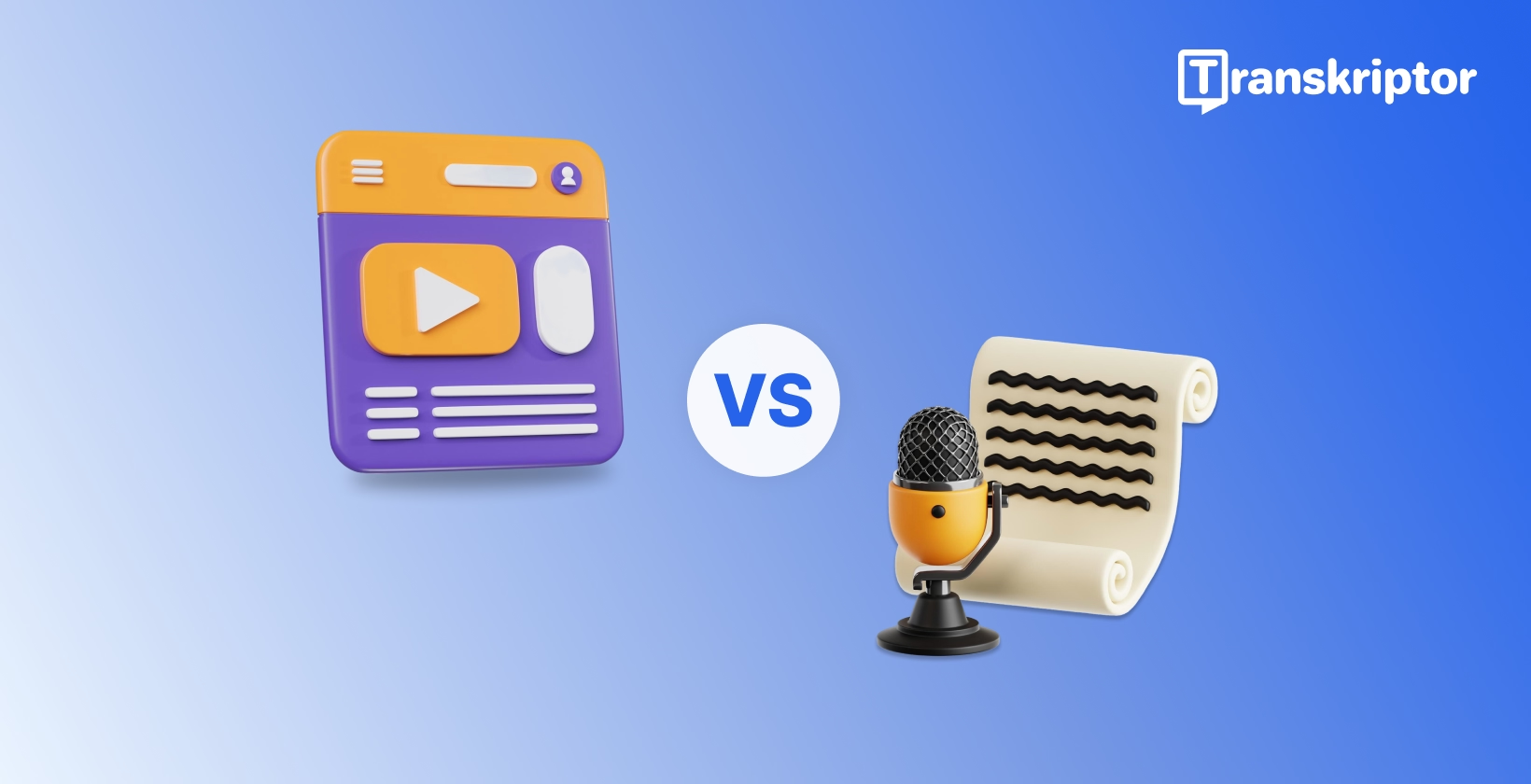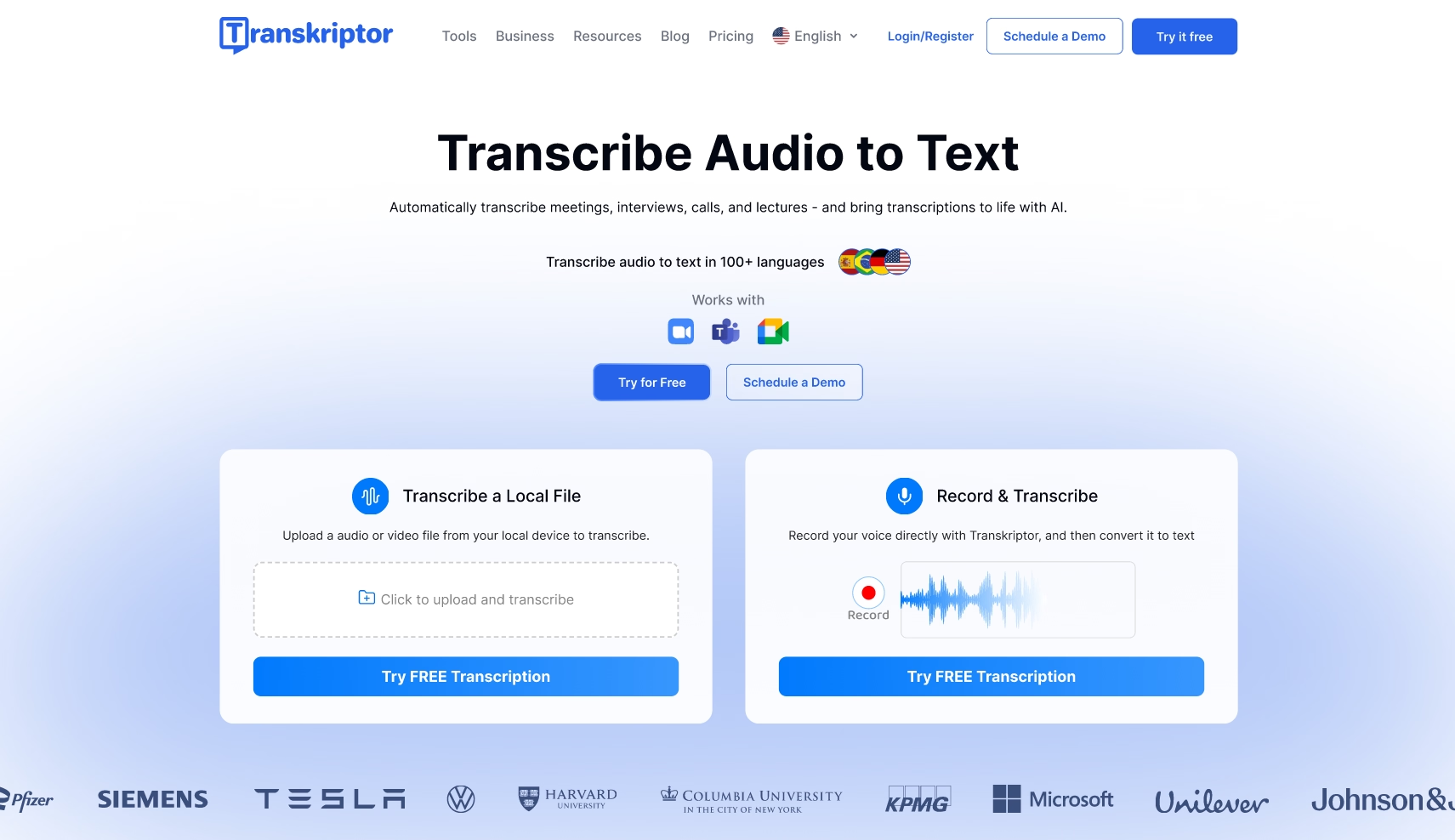
Captioner vs. Transcriptionist: What are the Differences?
Table of Contents
- Understanding Captioners and Transcriptionists
- Key Differences Between Captioning and Transcription
- When to Choose Captioning vs. Transcription
- The Evolution of Content Processing: Moving Beyond the Traditional Divide
- Transkriptor: Bridging the Gap Between Captioning and Transcription
- Implementing an All-in-One Solution with Transkriptor
- Conclusion
Transcribe, Translate & Summarize in Seconds
Table of Contents
- Understanding Captioners and Transcriptionists
- Key Differences Between Captioning and Transcription
- When to Choose Captioning vs. Transcription
- The Evolution of Content Processing: Moving Beyond the Traditional Divide
- Transkriptor: Bridging the Gap Between Captioning and Transcription
- Implementing an All-in-One Solution with Transkriptor
- Conclusion
Transcribe, Translate & Summarize in Seconds
In the fast-paced digital world, businesses, content creators, and educational institutions require efficient ways to convert spoken language into text. However, many struggle with deciding between captioning and transcription services. The confusion between a captioner and a transcriptionist often stems from the overlapping nature of their work.
In this guide, you’ll learn the key differences between captioner and transcriptionist, helping you determine the best service for your needs, such as Transkriptor. By understanding the essential aspects of both, you can make informed decisions that align with your content goals.

Understanding Captioners and Transcriptionists
Before deciding whether captions or transcripts are the best option for your content, you need to be completely familiar with the concepts. Here below, we explain what a captioner and a transcriptionist do:
What Does a Captioner Do?
A captioner specializes in converting spoken words into timed text that appears on a video screen. Captions are designed to provide accessibility for deaf or hard-of-hearing viewers and typically include non-verbal audio elements like sound effects and speaker identification. There are two main types of captioning: real-time and offline.
Captioners need specialized software like Transkriptor, Aegisub, CaptionMaker, or Adobe Premiere Pro to ensure synchronization and formatting. Captions are typically provided in formats such as SRT, VTT, or SCC, depending on platform requirements.
Real-Time Captioning
Real-time captioning is used for live events, such as news broadcasts, webinars, and conferences. It requires specialized stenography equipment or automatic speech recognition (ASR) technology to create instant captions with minimal delay.
Offline Captioning
Offline captioning involves creating captions for pre-recorded content, such as movies, educational videos, and marketing materials. Offline captioners have more time to edit, format, and synchronize captions for accuracy.
What Does a Transcriptionist Do?
A transcriptionist focuses on converting spoken language into a written document without the synchronization required for video content. Transcriptions can be verbatim (including all filler words and background noise) or edited (removing unnecessary elements for readability).
A transcriptionist listens to audio recordings, types the spoken content, and edits for clarity and accuracy. Another option is to use a reliable automated transcription software such as Transkriptor. Transcriptions are typically provided in DOCX, TXT, or PDF formats.
Verbatim Transcription
Verbatim transcription captures every spoken word, including filler words, stutters, and non-verbal sounds. This type is often used for legal proceedings, medical records, and research purposes where exact speech reproduction is essential.
Edited Transcription
Edited transcription focuses on readability by removing unnecessary filler words and correcting grammatical errors. This type is commonly used for business meetings, interviews, and academic research, where clarity is more important than verbatim accuracy.
Intelligent Transcription
Intelligent transcription summarizes speech while maintaining the intended meaning. It is ideal for content where conciseness and readability are crucial, such as keynote speeches, podcasts, and summaries of discussions.
Key Differences Between Captioning and Transcription
Although the required captioning and transcription skills might be similar, these two services have some important differences. Here are the key differences between captioning and transcription based on process and workflow comparison and tools and technology requirements:
Process and Workflow Comparison
When comparing captioning vs transcription services, the primary difference lies in their workflow and purpose:
- Time Constraints : Captioning (especially real-time captioning) operates under strict time constraints, requiring instant processing. Transcription, in contrast, allows for more flexibility in editing and accuracy.
- Technical Requirements : Captioning requires software for synchronizing text with video, whereas transcription relies more on text-editing tools.
- Output Specifications : Captions are formatted with timestamps, whereas transcriptions are usually plain text.
Tools and Technology Requirements
Both services rely on different tools and technologies to ensure accuracy and efficiency:
- Traditional Tools : Captioners use subtitle editors and stenography machines , while transcriptionists use audio players and word processing tools.
- Modern Solutions : AI-powered speech-to-text software has revolutionized both fields.
- Automation Possibilities : Services like Transkriptor now offer AI-driven solutions that merge captioning and transcription capabilities.

When to Choose Captioning vs. Transcription
While deciding whether to use captioning and transcription, you need to consider the content type, budget, and timeline factors. Here is a closer look at when to choose captioning vs. transcription:
Factor | Captioning | Transcription |
|---|---|---|
Best For | Videos, live events, educational content, entertainment | Podcasts, interviews, meetings, legal and medical records |
Primary Purpose | Enhances accessibility and engagement with synchronized text | Converts spoken content into a readable text format |
Industry Use | Marketing, media, entertainment, education | Legal, medical, journalism, business |
Cost | Higher due to synchronization needs | Generally lower since it doesn’t require syncing |
Turnaround Time | Real-time captioning is instant but may lack accuracy; pre-recorded captioning takes time to format | Can take longer due to editing but it ensures high accuracy |
Quality Standard | Must follow FCC captioning guidelines for accessibility | Focuses on readability and completeness |
Content Type Considerations
Understanding when to use captioning and transcription depends on the type of content. Live events, such as webinars, conferences, and news broadcasts, require real-time captioning to ensure accessibility for audiences, particularly those who are deaf or hard of hearing.
For pre-recorded content, including videos, documentaries, and educational materials, captioning is essential to provide synchronized text that enhances comprehension and engagement.
On the other hand, transcription is beneficial for converting spoken content from podcasts, interviews, and meetings into readable text that can be referenced later. Different industries have varying needs—legal and medical fields primarily use transcriptions for documentation and records, while the marketing and entertainment sectors rely on captions to boost accessibility and viewer engagement.
Budget and Timeline Factors
When considering professional captioning vs transcription, budget and turnaround time are crucial factors.
- Cost Comparisons : Captioning is often more expensive due to synchronization needs. Transcription services generally have lower costs.
- Turnaround Times : Real-time captioning is immediate but may have accuracy issues. Transcription allows for meticulous editing but takes longer.
- Quality Expectations : Captioning must meet specific formatting standards. Transcription prioritizes readability and completeness.
The Evolution of Content Processing: Moving Beyond the Traditional Divide
In this section, you’ll read about the limitations of traditional approaches and the rise of unified solutions:
Limitations of Traditional Approaches
Traditional methods of captioning and transcription have long been treated as separate processes, each requiring distinct tools and expertise. This division has resulted in several inefficiencies.
Firstly, you often need to invest in multiple tools to handle both tasks, leading to additional software costs and steep learning curves. Captioning requires synchronization with video, demanding specialized software like Aegisub or Adobe Premiere Pro, whereas transcription is usually performed using text-editing software with audio playback features.
Another major limitation is the increased expense associated with using separate services for captioning and transcription. Many businesses, content creators, and educational institutions struggle with the high costs of outsourcing these tasks or acquiring different tools for each process.
The Rise of Unified Solutions
With the advent of AI-driven platforms, the industry has begun shifting towards unified solutions that integrate both captioning and transcription functionalities into a single, seamless system. These modern solutions offer multiple advantages, streamlining the entire content processing workflow.
One of the most significant benefits is integration. AI-powered tools can now perform automatic transcription and captioning simultaneously, reducing the need for manual intervention and minimizing errors. This not only improves efficiency but also enhances accuracy by utilizing speech recognition algorithms that adapt to different accents and speaking styles.
The cost advantages of unified solutions are another compelling factor driving this shift. By merging captioning and transcription into a single platform, businesses and individuals can eliminate the need to invest in multiple services or software licenses.
Workflow optimization is another key advantage of these all-in-one solutions. Automation has significantly reduced the time required for captioning and transcription. AI-powered platforms can generate text in for live events while also providing automated editing tools for pre-recorded content.

Transkriptor: Bridging the Gap Between Captioning and Transcription
Transkriptor is an AI-powered platform that eliminates the need to choose between captioning vs transcription services by offering both in a single tool. You won’t need to think about which is better captioning or transcription for your content when you start to use Transkriptor:
Unified Solution for All Content Needs
Transkriptor is an advanced AI-powered tool designed to seamlessly integrate both captioning and transcription services into a single platform. Traditionally, users had to choose between these services separately, often requiring multiple tools or outsourcing to different providers. By bridging this gap, Transkriptor provides a more efficient and cost-effective solution, eliminating the hassle of using different platforms for captioning vs transcription services.
Key Features and Advantages
Transkriptor excels in several areas that make it stand out as an all-in-one solution:
- High Accuracy AI Transcription : Using advanced speech recognition technology, Transkriptor converts spoken words into written text with a high level of accuracy. This makes it useful for various industries, including legal, medical, and content creation, where precise documentation is required.
- Automated Captioning : Unlike manual captioning, which requires additional formatting and synchronization, Transkriptor automates the process by aligning captions with speech patterns, ensuring a natural and seamless viewing experience.
- Multiple Language Support : Businesses operating in global markets benefit from Transkriptor’s multilingual capabilities. Multiple language support makes Transkriptor a valuable tool for educators, marketers, and content creators catering to international audiences.
- Easy Export Options : The platform supports various file formats, including SRT, TXT, and DOCX, allowing users to export and integrate transcriptions and captions into different media and applications.

Use Cases and Applications
Transkriptor’s versatility extends to multiple industries:
- Content Creators : Video producers and social media influencers use Transkriptor to generate captions and transcripts that enhance accessibility and engagement for their audiences.
- Educational Institutions : Instructors and students leverage the tool to provide transcripts of lectures, ensuring everyone can access and review course materials easily.
- Media Production Companies : Film and television production teams use Transkriptor to streamline the subtitling process, saving time and effort in post-production.
Implementing an All-in-One Solution with Transkriptor
This section explains how to implement an all-in-one solution like Transkriptor for captioning and transcription:
Getting Started
Transkriptor is designed with a user-friendly interface, making it easy for beginners to start using the platform without extensive technical knowledge. You can upload audio or video files, select your desired output format, and begin the transcription or captioning process effortlessly.
Transkriptor supports various audio and video file formats such as MP3, MP4, WAV, and WEBM. It also provides rich exporting options such as DOC, PDF, TXT, and SRT.
By automating both captioning and transcription, Transkriptor reduces manual effort, allowing businesses and content creators to focus on producing quality content instead of spending hours on text conversion. To achieve the best results, you should ensure clear audio quality before transcription or captioning.
Maximizing Results
The accuracy of automated transcriptions can be significantly improved by using high-quality recordings. Avoiding noisy environments, speaking clearly, and using high-fidelity microphones all contribute to better results. Even though AI performs well, manually reviewing transcriptions can further refine accuracy by correcting minor errors in formatting or phrasing.
Conclusion
Choosing between a captioner and a transcriptionist depends on the nature of your content, budget, and accessibility needs. By understanding the key differences between captioning and transcription, businesses and creators can make informed decisions.
Traditional methods have limitations, but AI-powered solutions like Transkriptor now offer integrated services that streamline workflow, reduce costs, and enhance efficiency. Whether you need captions for video content or transcriptions for documentation, an all-in-one solution can help you maximize productivity and reach a broader audience effectively.
Frequently Asked Questions
Yes, modern AI platforms like Transkriptor offer both captioning and transcription services in a single solution. This allows businesses and content creators to process their content efficiently without needing separate tools or services.
Yes, many social media platforms like YouTube, Instagram, and TikTok support captioning. Adding captions can improve accessibility, increase engagement, and help videos reach a broader audience.
Open captions are permanently embedded in the video and cannot be turned off, while closed captions can be toggled on or off by the viewer.
Captions should be concise, properly timed, and formatted with clear line breaks. Using standard caption file formats like SRT and VTT ensures compatibility with different platforms.

